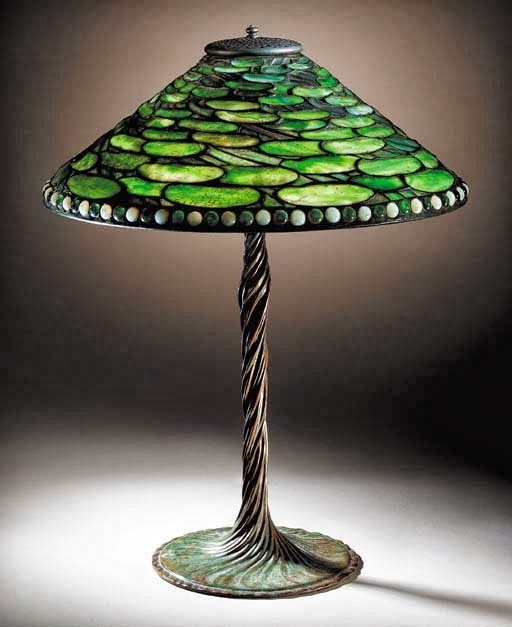This information relates to the "fair market" value of a Tiffany Studios lamp when sold at public auction or privately. The price or values one sees in a retail Tiffany or antique gallery or at an antique show, are often considerably higher than what one sees on the same (as close as possible) lamp at an auction or privately. This is due to overhead and other factors the dealer or retail store must factor into the price. Also, insurance appraisals are generally "inflated" on anything antique or unusual, including Tiffany Studios lamps.
These things generally factor into how much a Tiffany Studios lamp is worth It is interesting to note that even five lamps of the same pattern and size shade can vary in price greatly, due to the colors of glass in the shade, the type or types of glass used, the condition, and if it is a lamp with a base, the quality and desirability of the base.
1. Rarity: If it is a particularly rare shade design that Tiffany did not make many of, or that were expensive at the time of purchase in the early 20th century, c. 1900-1915 (The "Wisteria" pattern lamp is a good example, costing about $400. at that time) the value and desirability of the lamp can be greatly increased. Below is an example of a very nice authentic Tiffany Studios "Wisteria" table lamp:
2. The Colors In The Glass Shade: The colors of the glass in a Tiffany lamp shade, particularly the leaded glass shades, can make a large difference in value. One 18 inch dragonfly shaded table lamp can be worth 2-4 times or more from another the same size on the same base, simply because the colors are more vibrant and appealing to collectors. The same is true of course with his many different floral design shades.
3. Types of Glass Used: Tiffany had many kinds of glass he used in his leaded shades. If a lamp has "fancy" glass such as 'confetti,' or 'fractured,' it enhances the aesthetic look and rarity of the shade, therefore causing the value and appeal of the lamp to be higher. Likewise, the flat, plain glass, or the glass that the Tiffany Studios Lamp Department used, some of which was purchased from outside glass makers, is not as popular or attractive. This can cause a lamp to be worth less money. The bottom line regarding the glass is that value is mostly determined by the intensity of color and types of glass used.
4. Shade and Base Condition: While it is not uncommon for most leaded shades above 16" in diameter to have a very few tight "hairline cracks" in a few panes of glass (1-6 panes is considered minor) if there are excessive cracks or chips to the glass, or separation at the solder joints or seams in the shade, or if the shade is "out of round," these things can effect the value of a shade greatly. Even the most desirable shade with with dense colors and an appealing design is going to be devalued greatly if the condition is such that the lamp needs many thousands of dollars in restoration. After restoration of course, the lamp has lost some of it's "integrity" and value, since the original glass has been replaced.
5. Size and Shape of the Shade: Size is a factor in determining the value for all Tiffany Studios lamps. The shade size is most influential to the value. There are some rare 'miniature' shades where shades were produced in limited editions and therefore they are highly desirable today. Likewise, all other things being equal as to colors, condition, pattern, quality and type of glass, a larger shade on a desk, table, hanging or floor lamp is going to be worth more money to most collectors. Regarding shape: Some shade models like the 'helmet-shaped,' 'horizontally flat,' 'bell shape' or 'sharp-shouldered' are not generally as popular with collectors because their forms draw the eye first, before the viewer can focus and appreciate the designs and combinations of color in the shade.
6. Base Style: If the Tiffany lamp has a base, it can add a little or quite a bit to the overall value of a desk, table or floor lamp. The fancier and more unusual the base is, the more the total lamp will be worth to a collector. Some lamps have very fancy shades and are on plain bases, while some very plain shades have bases which are worth as much or more than the shades. Also, the correct or optimum base for a shade has great impact in today's market. Certain shades were designed with their own bases, and such pairings should never be violated or mixed up. Doing so will lower the appeal of the lamp and therefore the value. Today's well educated collectors are aware of what is considered the most desirable shade and base combination, and they will often shop for the two separately if necessary to get the ideally paired shade and base.
See below examples of two extremely fancy and valuable bases; one with 'blown out' glass (bottom photo) and one with a much sought after 'twisted vine' bronze base (top photo):


